Visual Metaphor Documentation
Dynamic Zero (动态清零)
Annika (Huiwei) Wen & Lydia (Dianyu) Lin

Concept & Story
Our project wanted to explore the boundaries between government surveillance and freedom of expression. The project title is Dynamic Zero. This was the policy in China during the COVID-19 crisis, and the full name is dynamic zero-COVID policy, which originally referred to eliminating every case of COVID-19 that was found. But here we play with words a little bit. Because what we see is that instead of zeroing out the cases, the brutal truths and residents’ messages seeking help were removed and zeroed out.
The inspiration for creating the project was actually quite simple. During the quarantine, we had limited footage to shoot, so we decided to start with thinking about what the things around us could metaphorically represent. I came up with the mechanical eyeball I purchased because of the Interaction Lab. The mechanical eyeball could be a metaphor for “surveillance” and contrast with the human eye. We settled on the theme of surveillance, reflecting on how people were forbidden to speak out during the intensified conflict following the outbreak of the Shanghai pandemic. In the production process, we gave another metaphorical meaning to the human eye – “witnessing”.
The story begins with a man opening his eyes. One person after another witnesses the chaos in Shanghai and wants to speak out and participate in the discussion. As the number of people talking grows, mechanical eyes – that is, government surveillance – join in, forcing one eye after another to close. At the same time, the discussion became fragmented and was deleted one by one. Eventually, only the mechanical eyes are left flashing with cold light. Everything was zeroed out.
During the isolation, feelings were overwhelming. We hope that after watching the video viewers can think critically about the recent news events and the bottom line of government surveillance on expression.
Creation Process & Execution

After discussing it together, I drew an abbreviated draft of the video and Lydia completed the storyboard.

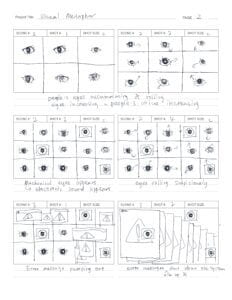
 Since we had a clear story line and changing mode, we basically followed the storyboard. In later stages, we changed the name of the project and added the branch line of changing figures.
Since we had a clear story line and changing mode, we basically followed the storyboard. In later stages, we changed the name of the project and added the branch line of changing figures.
The voice-over consists of real interviews with students around us. Upon Professor Ian’s suggestion, we used more neutral questions to get the real feelings of the interviewees.


Lydia designed the interview questions. I interviewed many friends, even a student who had gone to the mobile cabin hospital for isolation. This also made up the majority of the voice-over audio. Thank all my friends for their support!

I did not expect that assembling the mechanical eyes became a difficulty. The mechanical eye kit came from the “脑震荡” studio. (Surprisingly only one person besides me purchased it😶)

The assembly at the beginning was smooth. But when calibrating the servo arm, I couldn’t connect to the control app. Fortunately, after some twists and turns, this problem was solved. The finished product is very much as we expected.

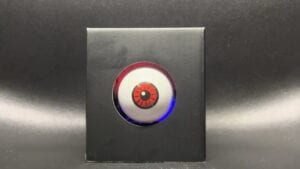

After connecting the APP, I can control the eye rotation and use it to shoot footage.
The next step is to shoot the human eye. I initially planned to use the school’s Canon EOS 6D, but the camera cannot focus at a distance where only one eye is in the viewfinder. I borrowed my friend’s Sony A7M4 and the same thing happened. In the end, we have to admit that the iPhone’s macro mode works better than a movie-quality camera when it comes to shooting close-ups of the human eye.
Regarding lighting, we at first borrowed professional lighting equipment from a friend, but eventually found that ordinary lamp was more flexible. The shoot looked simple, all fixed camera positions, but the process was actually quite frustrating. All the material that I first found friends to shoot was missing, so I had no choice but to shoot again. However, I found that due to different lighting angles and shooting distances, some people’s eyes were clear, while others were blurry. I had to find my friends for the third time to make up the footage. I found fourteen friends to shoot and finally picked out nine clips. I really appreciate my friends!

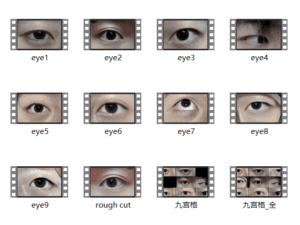
Professor Ian raised his concern after watching the rough cut that we had a rather homogeneous shot. I understood this deeply and as a result our work relied heavily on post production. The post editing was a huge amount of work. I superimposed realistic images with reduced transparency over the three separate open eyes at the beginning to enhance the sense of ” witnessing”. In the transitions where the discussion intensified, I interspersed images of uncovered mechanical eyes to create a sense of conflict. I also learned how to create glitch effects to enrich the image.

The most difficult part is the climax of the video. One after another, the eyes appear to form a nine-panel grid. After the mechanical eyes appear, one by one the eyes close and disappear. I also needed to add error pop-ups and glitch effects. Due to the limited length of the footage, I needed to precisely calculate the timing and the moment when the eyes appeared and disappeared, and to give the video variable speed. To do this, I even counted the time each person opened/looked straight ahead/rotated their eyes/closed their eyes and planned everything.


Well, the final result is satisfactory. It worth the effort.
Collaboration
This was the division of labor we had planned at the beginning.
| Task | Owner | Start Date | Due Date | Duration | PCT of Task Complete |
| Make a mechanical eye | Annika | 4.28 | 4.29 | 2 days | 5% |
| Shooting raw video footage | Annika | 4.30 | 5.3 | 4 days | 25% |
| Interview | Annika&Lydia | 4.28 | 4.30 | 3 days | 35% |
| Produce the audio | Lydia | 5.1 | 5.4 | 4 days | 55% |
| Video rough cut | Annika&Lydia | 5.4 | 5.8 | 5 days | 80% |
| Final modification | Annika&Lydia | 5.9 | 5.12 | 4 days | 100% |
We originally planned to work together on the video editing. Since the video footage were all on my computer, we ended up splitting up the work completely. I took care of all the video post-production tasks, while Lydia mixed the audio and added subtitles.

Although our video and audio were produced separately, the results proved that we worked well together. I was amazed by Professor Inmi’s appreciation of how well the image and sound worked together without (due to the language barrier) understanding the content. During the production process, we adjusted each other several times to reach a fine rhythm and aesthetics in the end.
We all put a tremendous amount of effort into this project. Since I provided many of the interview audios and knew what they were originally like, I was amazed to hear the mix. Lydia created the voice-over that fit my imagination perfectly, and I did my best to make the images match the audio to have a strong impression for viewers.
I love the feeling of two partners brainstorming together and working to improve the video. We’ve been having heated discussions about the concept, frame sequence and execution, and have made adjustments to many tiny details. We also added the successful subplot of changing numbers. Our ideas collided to spark ideas. It was really a great creating experience. Many thanks to Lydia!
Aesthetics & Results
Tiger expressed his high appreciation. I think our video is extremely powerful.

For the tone, I cropped the material, leaving only one eye, and made color adjustments. On the right, from top to bottom, are: the failed lighting example, the uncropped and color unadjusted footage, and the presented image in the video.
In the nine-frame section, in order to set the stage for the appearance of the mechanical eye, I adjusted the tone of the video to a more disturbingly nearly black-and-white tone. The panicked rotation of the human eye creates a tense atmosphere, observing where the monitors are. The pop-ups windows, uneasy red and black color, along with the electric and error sound effects in the background, succeed in bringing the video to a climax.


In addition to visual metaphorical images with a sense of absurdity and special effects, we have images of reality. The scene reflected in the eyes at the beginning, the screenshots at the end, and the interview audio are all real. The combination of reality and fiction can better arouse the audience’s criticism of reality.

Adding the changing numbers was thought up after revising the project title. The 0 at the beginning and the end form a counter-color, leading people to think about what exactly is being zeroed out. By the way, 25147 is the peak daily growth of confirmed cases in Shanghai.
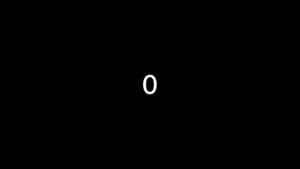


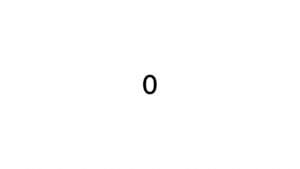
All the above images are combined together to give the video a great rhythm and aesthetic. The appearance of mechanical eyes in conjunction with the glitchy sound breaks the balance of people telling what they witnessed. Footage and audio work together to superimpose the sense of conflict, eventually leaving only the mechanical eyes and pulling the camera closer. The news report about the dynamic zero-COVID policy that rings out in the quiet impresses a sense of shock.
All in all, I am very satisfied with this project. Although it won’t be released in a short time, I think it brings this semester of communication lab to a successful conclusion. Thanks my partner Lydia! This project would not have been so successful without you. Thank you Professor Ian for your advice. Many thanks to all my friends who offered their help (too many people, I’ll compile a list when I get a chance). Thank you to Professor Inmi and Tiger who gave positive feedback, which gave me a lot of confidence. And finally, thanks to myself who put in a great effort! I’m truly proud of myself!